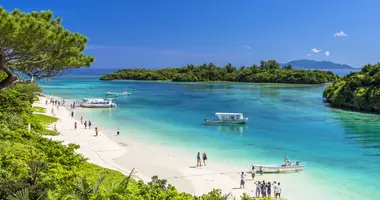Nagasaki China Town Shinchi
- Published on : 07/10/2014
- by : Japan Experience
- Youtube
Nagasaki China Town, Shinchi 長崎新地中華街
The China Town in Nagasaki, Shinchi, is one of Japan's three designated Chinatowns along with the Nankin-machi Chinatown in Kobe and the Yokohama Chukagai in Yokohama.
Shinchi is Japan's oldest Chinatown and has been in existence since before the Edo Period of Japanese history, when the Dutch on Dejima and the Chinese were allowed to trade in Japan's only open port to foreigners at the time.

Nagasaki Lantern Festival; walking under the lanterns in Shianbashi
History of Nagasaki China Town
Chinese traders had been active in Nagasaki since well before the Edo Period and their influence on the city has been profound. Some estimates are that the Chinese made up 15% of the citizens of Nagasaki in the 17th century.
Meganebashi ("Spectacles Bridge"), a famous Nagasaki landmark, was designed by a Chinese monk, Sofukuji Temple is an authentic Ming period Chinese temple built in 1629. Kofukuji Temple known as the "Chinese Temple" was also established by the city's Chinese residents in the early seventeenth century. The Confucius Shrine in Nagasaki is a later addition and was constructed in 1893 during the Meiji Period.
As well as the city's architecture, the Chinese left their mark on the local cuisine, with champon and sara udon, two of the Nagasaki's Chinese-inspired dishes. Chinese Dragon boat races take place in the annual Peiron festival in Nagasaki Harbor.
At first the Chinese were restricted to an area of landfill on the coast called Tojin Yashiki, but after Nagasaki was opened as a Treaty Port in 1859, the Chinese community moved to what is now the Shinchi district.
Now there are over 50 Chinese restaurants and souvenir shops in Shinchi, concentrated in an area of narrow streets and arcades - shotengai.
A number of Chinese gates have been erected in the district and a stage for performances of dancing, martial arts and Chinese acrobatics during the Nagasaki Lantern Festival.

Nagasaki Lantern Festival in Shinchi Chinatown
The Nagasaki Lantern Festival celebrates Chinese New Year and the city's Chinese heritage. Minato Park is the festival's main venue and huge colorful lanterns are erected each year.
There are performances of Chinese music including the Erhu, lion and dragon dances, processions and the "Emperor's Parade" with participants in traditional Chinese costume carrying the "Emperor" and "Empress" through the streets on palanquins. The Mazu Procession recreates the custom of Chinese sailors carrying Mazu, the god of safe seafaring, to Kofukuji to give thanks for a safe voyage. Now the procession is performed twice from the Confucius Shrine to Kofukuji and then on the following Sunday back to the Confucius Shrine.
The 4-star Nagasaki Washington Hotel is right in the heart Nagasaki China Town and the 3-star Dormy Inn Nagasaki is also close by to Shinchi.

Nagasaki Lantern Festival, Shianbashi arcade, Japan

Nagasaki Chinatown's Lantern Festival to celebrate Chinese New Year
Getting to Nagasaki China Town
Tram
Tsukimachi tram stop on lines 1 and 5 of the Nagasaki tram system is the nearest stop to Shinchi and is about 8 minutes from Nagasaki Station.

Confucius Shrine, Nagasaki

Large scale lanterns, Nagasaki Lantern Festival
Book Hotel Accommodation in Nagasaki
Books on Japan
Nagasaki China Town: read a guide to Shinchi, the oldest Chinatown in Japan and home to the colorful Nagasaki Lantern Festival at Chinese New Year.

















